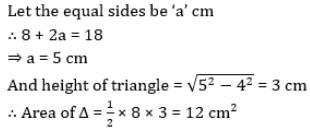Teaching Exam > Teaching Questions > The base of an isosceles triangle is 8 cm and...
Start Learning for Free
The base of an isosceles triangle is 8 cm and its perimeter is 18 cm. The area of triangle is
- a)12 cm2
- b)24 cm2
- c)18 cm2
- d)14 cm2
Correct answer is option 'A'. Can you explain this answer?
Verified Answer
The base of an isosceles triangle is 8 cm and its perimeter is 18 cm. ...

Most Upvoted Answer
The base of an isosceles triangle is 8 cm and its perimeter is 18 cm. ...
Given:
- Base of the isosceles triangle = 8 cm
- Perimeter of the triangle = 18 cm
To find:
- Area of the triangle
Solution:
Step 1: Finding the length of the equal sides
- An isosceles triangle has two equal sides.
- Let's assume the length of one of the equal sides is 'x' cm.
- Since the perimeter of the triangle is 18 cm, we can write the equation as:
Base + 2 * Equal sides = Perimeter
8 + 2x = 18
2x = 18 - 8
2x = 10
x = 10/2
x = 5
Step 2: Finding the area of the triangle
- The area of a triangle can be calculated using the formula:
Area = (Base * Height)/2
Step 3: Finding the height of the triangle
- In an isosceles triangle, the height is the perpendicular distance from the base to the vertex opposite the base.
- We can use the Pythagorean theorem to find the height.
- The height divides the isosceles triangle into two congruent right-angled triangles.
- Let's consider one of these right-angled triangles.
- The base of the right-angled triangle is half of the base of the isosceles triangle, which is 8/2 = 4 cm.
- The hypotenuse of the right-angled triangle is one of the equal sides of the isosceles triangle, which is 5 cm.
Using the Pythagorean theorem:
height^2 + base^2 = hypotenuse^2
height^2 + 4^2 = 5^2
height^2 + 16 = 25
height^2 = 25 - 16
height^2 = 9
height = sqrt(9)
height = 3
Step 4: Calculating the area
- Now that we have the base and height, we can substitute them into the area formula.
Area = (Base * Height)/2
Area = (8 * 3)/2
Area = 24/2
Area = 12 cm^2
Answer:
The area of the given isosceles triangle is 12 cm². Therefore, the correct option is A) 12 cm².
- Base of the isosceles triangle = 8 cm
- Perimeter of the triangle = 18 cm
To find:
- Area of the triangle
Solution:
Step 1: Finding the length of the equal sides
- An isosceles triangle has two equal sides.
- Let's assume the length of one of the equal sides is 'x' cm.
- Since the perimeter of the triangle is 18 cm, we can write the equation as:
Base + 2 * Equal sides = Perimeter
8 + 2x = 18
2x = 18 - 8
2x = 10
x = 10/2
x = 5
Step 2: Finding the area of the triangle
- The area of a triangle can be calculated using the formula:
Area = (Base * Height)/2
Step 3: Finding the height of the triangle
- In an isosceles triangle, the height is the perpendicular distance from the base to the vertex opposite the base.
- We can use the Pythagorean theorem to find the height.
- The height divides the isosceles triangle into two congruent right-angled triangles.
- Let's consider one of these right-angled triangles.
- The base of the right-angled triangle is half of the base of the isosceles triangle, which is 8/2 = 4 cm.
- The hypotenuse of the right-angled triangle is one of the equal sides of the isosceles triangle, which is 5 cm.
Using the Pythagorean theorem:
height^2 + base^2 = hypotenuse^2
height^2 + 4^2 = 5^2
height^2 + 16 = 25
height^2 = 25 - 16
height^2 = 9
height = sqrt(9)
height = 3
Step 4: Calculating the area
- Now that we have the base and height, we can substitute them into the area formula.
Area = (Base * Height)/2
Area = (8 * 3)/2
Area = 24/2
Area = 12 cm^2
Answer:
The area of the given isosceles triangle is 12 cm². Therefore, the correct option is A) 12 cm².

|
Explore Courses for Teaching exam
|

|
Question Description
The base of an isosceles triangle is 8 cm and its perimeter is 18 cm. The area of triangle isa)12cm2b)24cm2c)18cm2 d)14cm2Correct answer is option 'A'. Can you explain this answer? for Teaching 2025 is part of Teaching preparation. The Question and answers have been prepared according to the Teaching exam syllabus. Information about The base of an isosceles triangle is 8 cm and its perimeter is 18 cm. The area of triangle isa)12cm2b)24cm2c)18cm2 d)14cm2Correct answer is option 'A'. Can you explain this answer? covers all topics & solutions for Teaching 2025 Exam. Find important definitions, questions, meanings, examples, exercises and tests below for The base of an isosceles triangle is 8 cm and its perimeter is 18 cm. The area of triangle isa)12cm2b)24cm2c)18cm2 d)14cm2Correct answer is option 'A'. Can you explain this answer?.
The base of an isosceles triangle is 8 cm and its perimeter is 18 cm. The area of triangle isa)12cm2b)24cm2c)18cm2 d)14cm2Correct answer is option 'A'. Can you explain this answer? for Teaching 2025 is part of Teaching preparation. The Question and answers have been prepared according to the Teaching exam syllabus. Information about The base of an isosceles triangle is 8 cm and its perimeter is 18 cm. The area of triangle isa)12cm2b)24cm2c)18cm2 d)14cm2Correct answer is option 'A'. Can you explain this answer? covers all topics & solutions for Teaching 2025 Exam. Find important definitions, questions, meanings, examples, exercises and tests below for The base of an isosceles triangle is 8 cm and its perimeter is 18 cm. The area of triangle isa)12cm2b)24cm2c)18cm2 d)14cm2Correct answer is option 'A'. Can you explain this answer?.
Solutions for The base of an isosceles triangle is 8 cm and its perimeter is 18 cm. The area of triangle isa)12cm2b)24cm2c)18cm2 d)14cm2Correct answer is option 'A'. Can you explain this answer? in English & in Hindi are available as part of our courses for Teaching.
Download more important topics, notes, lectures and mock test series for Teaching Exam by signing up for free.
Here you can find the meaning of The base of an isosceles triangle is 8 cm and its perimeter is 18 cm. The area of triangle isa)12cm2b)24cm2c)18cm2 d)14cm2Correct answer is option 'A'. Can you explain this answer? defined & explained in the simplest way possible. Besides giving the explanation of
The base of an isosceles triangle is 8 cm and its perimeter is 18 cm. The area of triangle isa)12cm2b)24cm2c)18cm2 d)14cm2Correct answer is option 'A'. Can you explain this answer?, a detailed solution for The base of an isosceles triangle is 8 cm and its perimeter is 18 cm. The area of triangle isa)12cm2b)24cm2c)18cm2 d)14cm2Correct answer is option 'A'. Can you explain this answer? has been provided alongside types of The base of an isosceles triangle is 8 cm and its perimeter is 18 cm. The area of triangle isa)12cm2b)24cm2c)18cm2 d)14cm2Correct answer is option 'A'. Can you explain this answer? theory, EduRev gives you an
ample number of questions to practice The base of an isosceles triangle is 8 cm and its perimeter is 18 cm. The area of triangle isa)12cm2b)24cm2c)18cm2 d)14cm2Correct answer is option 'A'. Can you explain this answer? tests, examples and also practice Teaching tests.

|
Explore Courses for Teaching exam
|

|
Signup for Free!
Signup to see your scores go up within 7 days! Learn & Practice with 1000+ FREE Notes, Videos & Tests.


















